Architecture Home Styles
Retro 1960s Decor: A Step-by-Step How-To Guide
Open the door to a nostalgic world of 1960s decor, where every step holds the key to transforming your space – are you ready to step back in time?
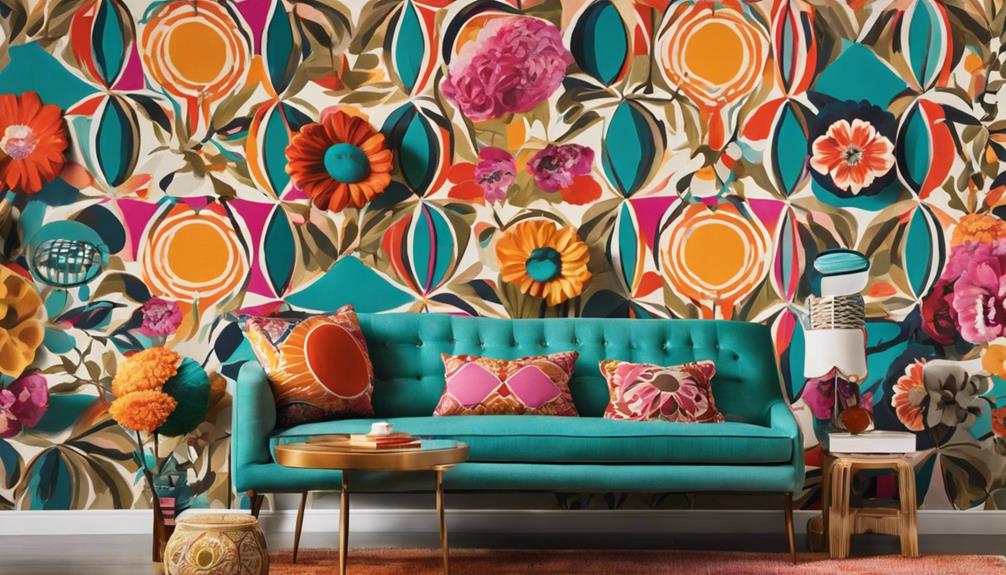
When it comes to diving into the world of retro 1960s decor, it's like unraveling a time capsule of design treasures waiting to be rediscovered. The allure of this era's aesthetic can be both captivating and challenging, but fear not, as we are here to guide you through the intricate process of transforming your space.
From selecting the perfect color palette to sourcing authentic vintage pieces, each step holds the promise of bringing your vision to life.
So, are you ready to embark on this journey back in time, where every detail carries the essence of a bygone era, waiting to be resurrected in your modern-day sanctuary?
Key Takeaways
- Embrace bold and vibrant retro colors like avocado green and mustard yellow for an authentic 1960s look.
- Mix and match bold patterns with clean lines to achieve a balanced and stylish retro aesthetic.
- Incorporate authentic materials such as rich woods and wicker to capture the essence of the era.
- Create a focal point with statement pieces like unique furniture shapes or standout artworks for a visually engaging space.
Choosing Retro Color Schemes
When diving into the vibrant world of 1960s retro decor, selecting the perfect color scheme is essential to capturing the era's lively and eclectic spirit. In the vintage realm of 1960s design, bold and vibrant colors reign supreme, infusing spaces with energy and character.
Earthy tones like avocado green, burnt orange, and mustard yellow reflect a connection to nature that was prevalent during this era, adding warmth and a touch of nostalgia to any room.
On the other end of the spectrum, pastel shades such as baby blue, pink, and mint green offer a softer, more delicate option for those seeking a retro look with a gentle touch.
The beauty of 1960s color schemes lies in the ability to mix and match hues freely, allowing for a creative explosion of individuality in decor choices. Whether opting for striking contrasts like teal and red or embracing the harmonious blend of purple and mustard, the key to authentic 1960s retro decor is embracing color with confidence and flair.
Incorporating Bold Patterns
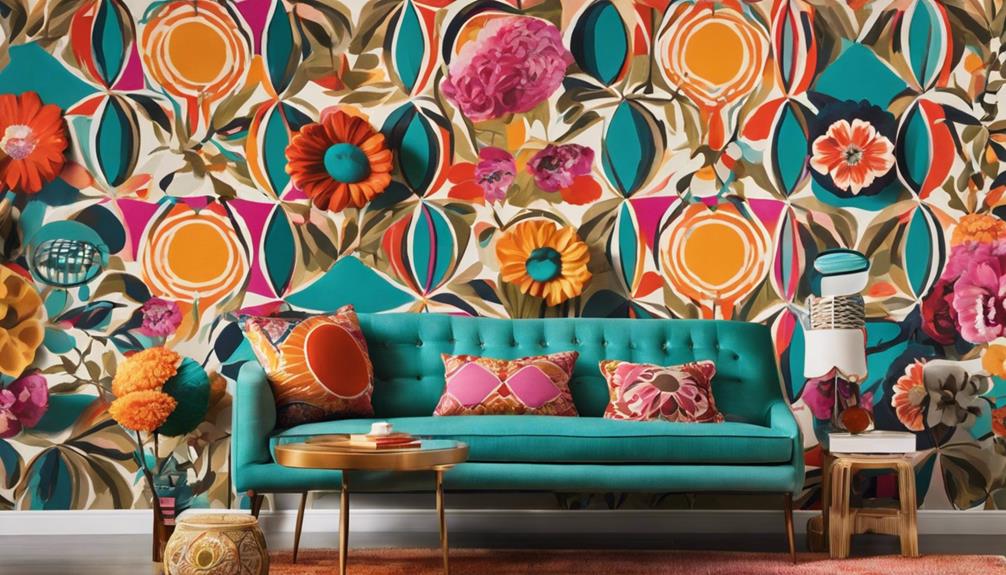
Bold patterns in 1960s retro decor infuse spaces with a dynamic visual energy, capturing the era's iconic style and spirit.
When incorporating bold patterns into your decor, consider using elements like geometric rugs, abstract wallpapers, and floral prints to add a touch of retro flair. Pairing these bold patterns with clean lines can create a harmonious balance that showcases the best of both worlds.
For a vintage touch, think about incorporating checkered tile floors or damask wallpapers, adding a classic yet bold statement to the space. To achieve a cohesive look, balance the bold patterns with neutral elements to prevent overwhelming the room and maintain a stylish retro aesthetic.
Mixing Authentic Materials
Incorporating authentic materials from the 1960s such as rich woods, chrome metals, and wicker can elevate the retro vibe of your space to new heights. To achieve a truly authentic retro look, consider the following:
- Adding Funky Updates: Integrate rattan furniture pieces to infuse a touch of bohemian charm. Pair them with marble or metal accents for a modern twist on classic 1960s style.
- Creating Depth and Texture: Mix diverse materials like wood, metal, and wicker to create visual interest. This combination not only stays true to the era but also adds layers of texture and dimension to your space.
- Blending Vintage with Modern: Seek out furniture with unique shapes that blend vintage forms with mid-century modern aesthetics. These unique furniture shapes are key in capturing the essence of the 1960s while keeping your space fresh and innovative.
Creating a Focal Point
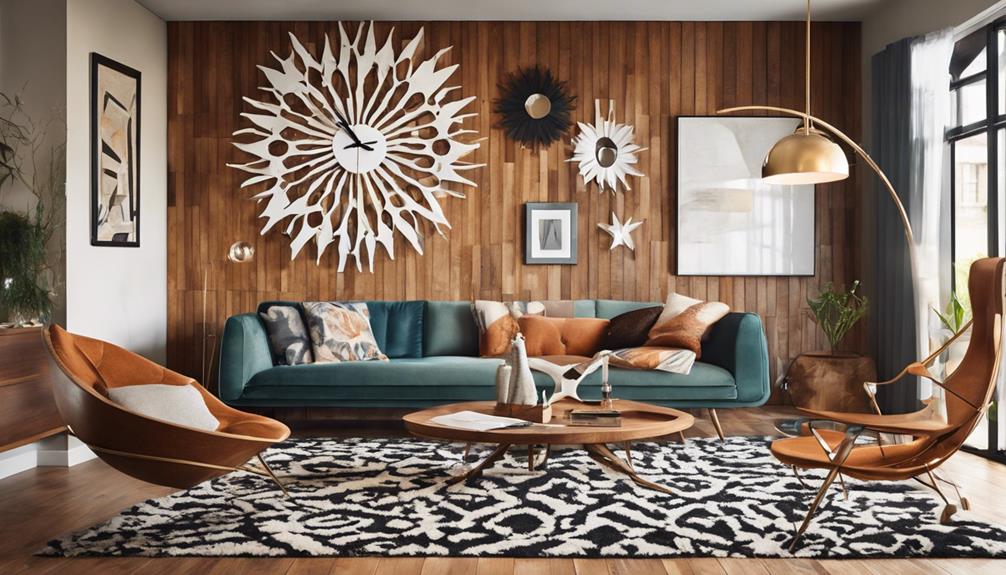
To establish a captivating focal point in your retro 1960s-inspired space, consider incorporating a statement piece that commands attention and sets the tone for the room's design aesthetic. A bold geometric rug or a vibrant abstract painting can serve as a striking centerpiece. Additionally, choosing unique furniture with distinctive shapes or colors can draw the eye and anchor the room's style. Lighting plays a crucial role in highlighting the focal point; opt for a vintage chandelier or a modern pendant light to add flair and illumination.
| Key Elements | Description | Importance |
|---|---|---|
| Geometric Rug | Adds visual interest | Anchors the space |
| Abstract Painting | Infuses color and artistry | Creates a focal point |
| Vintage Chandelier | Provides ambient lighting | Enhances the atmosphere |
Incorporating standout wallpaper designs, large-scale artworks, or creating a gallery wall with vintage art can also elevate the room's focal point, adding depth and character to the overall design scheme. By strategically placing these elements, you can ensure a cohesive and visually engaging focal point that captures the essence of retro 1960s decor.
Styling Unique Furniture Shapes
When styling unique furniture shapes in a retro 1960s-inspired space, consider incorporating iconic mid-century modern designs by renowned furniture creators. To achieve an authentic look with a modern twist, mix vintage pieces with contemporary elements.
Here are three key tips for styling unique furniture shapes in your space:
- Embrace Retro Futurism: Experiment with space-age furniture like pod chairs and Sputnik chandeliers to infuse a retro-futuristic vibe into your decor.
- Go Organic: Opt for furniture with organic curves and unconventional forms to capture the avant-garde spirit of 1960s design.
- Iconic Designs: Look for mid-century modern classics such as egg chairs, bubble chairs, and kidney-shaped tables by designers like Eero Saarinen and Charles and Ray Eames to add a touch of vintage charm to your space.
Frequently Asked Questions
What Decor Style Is From the 1960s?
In the 1960s, decor style was all about embracing bold and vibrant colors like orange, green, and yellow. Large designs and geometric patterns were key to creating a fun and eye-catching atmosphere.
Feature walls, unique furniture pieces, and contemporary furnishings by designers such as Orla Kiely were popular elements of this era. Clashing patterns and busy designs added a fabulous finishing touch to retro interiors, while quirky furniture, soft furnishings, and funky art brought character and charm to spaces with retro vibes.
How to Create a Vintage Home Decor?
Creating a vintage home decor is a fun adventure where we blend old charm with modern flair.
We infuse our space with vibrant colors, mix textures like wood and metal, and add quirky accessories to evoke nostalgia.
By combining unique seating options and sustainable pieces, we craft a home that's both timeless and trendy.
Let's embark on this journey of creativity and design to transform our space into a vintage haven.
How Can I Make My House Look Retro?
When creating a retro aesthetic, we infuse bold colors, mix patterns, select unique furniture, and add vintage art pieces.
To achieve the desired 1960s look, incorporate vibrant hues like red, blue, orange, pink, and purple. Mix geometric rugs, floral patterns, and abstract wallpapers for a retro-inspired space.
Choose furniture with unique shapes and diverse materials. Accessorize with retro art such as abstract, pop art, and psychedelic designs.
How Can I Make My Room Look Retro?
To make our room look retro, we should focus on bold colors like red, blue, orange, pink, and purple. Mixing patterns carefully and selecting furniture with unique shapes and materials such as rich woods, metals, and wicker can enhance the authentic retro feel.
Adding retro elements like abstract art, pop art, and psychedelic designs, as well as vintage accessories like wall tapestries, lava lamps, and old rotary phones, will complete the retro 1960s decor style.
Conclusion
As we step back in time with our retro 1960s decor, let's remember that true nostalgia isn't just about recreating the past, but about celebrating the creativity and individuality of that era.
So, while we may be embracing bold colors and funky patterns, let's not forget to add our own personal touch and make this space uniquely ours.
After all, the best retro decor is a blend of the old and the new, just like us.
- About the Author
- Latest Posts
Introducing Ron, the home decor aficionado at ByRetreat, whose passion for creating beautiful and inviting spaces is at the heart of his work. With his deep knowledge of home decor and his innate sense of style, Ron brings a wealth of expertise and a keen eye for detail to the ByRetreat team.
Ron’s love for home decor goes beyond aesthetics; he understands that our surroundings play a significant role in our overall well-being and productivity. With this in mind, Ron is dedicated to transforming remote workspaces into havens of comfort, functionality, and beauty.
Architecture Home Styles
How to Explore Native Houses in Indonesia
Catch a glimpse of Indonesia's cultural treasures through native houses, where each intricate detail holds a secret waiting to be discovered.

So, you think you've seen it all in Indonesia? Well, think again. Exploring native houses in this diverse archipelago offers a glimpse into a world where tradition meets craftsmanship in a harmonious blend.
From the intricate carvings to the unique architectural designs, each house tells a story waiting to be uncovered, inviting us to step into a realm where time seems to stand still.
But what lies beyond the façade of these cultural gems is a journey that promises to unravel the tapestry of Indonesia's rich heritage, revealing a side often overlooked by many travelers.
Key Takeaways
- Visit Batak, Toraja, and Joglo Houses for diverse architectural experiences.
- Discover intricate carvings and symbolic details in traditional Indonesian homes.
- Immerse in cultural heritage through communal spaces and ancient craftsmanship.
- Learn about Indonesia's rich history and values by exploring native houses.
Traditional Houses in Indonesia
In Indonesia, traditional houses embody rich cultural heritage through their unique architectural designs and symbolism. Among these remarkable dwellings, the boat-shaped houses stand out for their distinctive characteristics. The Batak House, found in certain regions, showcases intricate carvings and utilizes natural materials, reflecting a deep connection to the environment. These boat-shaped structures not only serve as homes but also as symbols of cultural identity and traditions passed down through generations.
The boat-shaped design of these traditional houses in Indonesia not only provides shelter but also represents a deeper meaning within the community. The intricate carvings on the Batak House, for example, tell stories of ancestry and spiritual beliefs, adding layers of significance to the architectural aesthetics. Through these boat-shaped dwellings, the indigenous peoples of Indonesia honor their heritage and preserve their cultural roots in a rapidly changing world.
Cultural Significance of Indigenous Dwellings

Exploring the intricate cultural significances embedded within indigenous dwellings in Indonesia unveils a tapestry of architectural symbolism and traditional values that resonate deeply within the communities they inhabit. These houses serve as more than mere shelters; they embody the cultural beliefs and practices of the diverse Indonesian tribes. The multi-generational living arrangements seen in houses like the Rumah Gadang in West Sumatra and the Rong Houses in Dayak communities highlight the importance of family and community ties in Indonesian society.
Moreover, the communal living spaces found in the Tongkonan House in Tana Toraja and the Uma Lulik in Timor foster a sense of togetherness and shared responsibilities among the inhabitants. Each architectural element, from the intricate carvings to the circular shapes and elevated stilts, holds deep symbolic meaning rooted in centuries-old traditions. These indigenous dwellings aren't just physical structures but living embodiments of Indonesia's rich cultural heritage, where every beam and wall tells a story of cultural continuity and communal harmony.
Top Native Houses to Visit
With intricate architectural designs and rich cultural symbolism, a journey to explore the top native houses in Indonesia promises a captivating immersion into the country's diverse heritage. Here are some of the top native houses you shouldn't miss:
| Native House | Features |
|---|---|
| Batak Houses | Boat-shaped roofs, intricate carvings, spaces for daily life activities like a living room and dining room. |
| Toraja Houses | Distinct saddleback roof design, used in ceremonies, areas for daily life such as a living room and dining room. |
| Joglo Houses | Elaborate wooden structures, symbolizing social hierarchy, with designated spaces for a living room and dining room. |
These native houses offer insights into the daily lives of the people inhabiting them. From the communal spaces like the living room where gatherings take place to the dining room where meals are shared, each house reflects the cultural practices and traditions of its respective community. Exploring these spaces provides a unique opportunity to understand the interconnectedness between architecture, daily life, and cultural identity in Indonesia.
Exploring Architectural Features

Amidst the vibrant tapestry of Indonesia's architectural landscape, one encounters a rich mosaic of cultural intricacies within the native houses that stand as living testaments to the country's diverse heritage. As we delve into exploring the architectural features of these remarkable dwellings, we're greeted by a fusion of craftsmanship and symbolism that captivates the senses:
- Boat-shaped roofs that gracefully mimic the curves of traditional Indonesian vessels, offering a nod to the nation's maritime history.
- Intricate carvings adorning the facades and interiors, telling stories of myths, legends, and ancestral wisdom.
- Wooden craftsmanship that showcases the mastery of artisans, each piece meticulously crafted to perfection.
- Natural materials seamlessly integrated into the structures, connecting the homes to the earth and reflecting a harmonious relationship with nature.
- Symbolic details embedded in every corner, from the layout to the decorations, embodying cultural beliefs and societal values passed down through generations.
Exploring these architectural marvels unveils a world where history, artistry, and tradition converge in a celebration of Indonesia's rich cultural heritage.
Immersing in Indonesian Hospitality
Immerse yourself in the captivating tapestry of traditional Indonesian hospitality by residing in native houses like the Batak House in North Sumatra or the Rumah Gadang in West Sumatra. These native houses not only offer a place to stay but also provide a gateway to the cultural heritage of Indonesia. The intricate carvings, boat-shaped roofs, and eco-friendly construction of these houses showcase the deep-rooted traditions and craftsmanship of the local communities.
Here is a table highlighting some of the unique aspects of traditional Indonesian hospitality found in native houses:
| Aspect | Description |
|---|---|
| Architectural Features | Intricate carvings, boat-shaped roofs |
| Social Significance | Symbolism of social hierarchy in houses like the Joglo House in Central Java |
| Eco-Friendly Construction | Use of sustainable materials like bamboo and thatch in houses like the Sasak House in Lombok |
| Spiritual Connections | Preservation of spiritual connections and communal living traditions in houses like the Uma Lulik in Timor or the Honai House in Papua |
| Local Way of Life | Experience the daily lives and customs of the local communities while staying in these native houses |
Staying in these native houses will not only provide you with a unique accommodation experience but also a deep dive into the rich tapestry of Indonesian traditions and hospitality.
Frequently Asked Questions
What Are Traditional Indonesian Houses Called?
Traditional Indonesian houses are called 'Rumah Adat.' These structures are more than just dwellings; they're living representations of Indonesia's rich cultural tapestry. Crafted from natural materials like wood and thatch, they stand as testaments to the country's diverse traditions.
Each region boasts its own unique design, influenced by local customs and beliefs. Exploring these native houses allows us to delve into the heart of Indonesia's vibrant heritage and architectural ingenuity.
What Is Indonesian Housing Like?
Indonesian housing embodies a rich tapestry of cultures and traditions, showcasing unique architecture and sustainable practices. From boat-shaped roofs to intricate carvings, these homes reflect a deep connection to nature and community.
Families often live together in multi-story structures, fostering bonds and kinship. Sustainability and cultural symbolism intertwine in Indonesian homes, creating a harmonious blend of functionality and heritage preservation.
Each dwelling tells a story of tradition, innovation, and unity.
What Is Typical Indonesian Housing?
We'll dive into the essence of typical Indonesian housing, showcasing the diverse array of styles like Batak, Toraja, Joglo, and more. These houses boast unique architectural features, reflecting the rich heritage of Indonesia's indigenous communities.
From intricate carvings to bamboo and thatch construction, each house tells a story of cultural significance and tradition. Multi-generational living arrangements further deepen the bond between people, highlighting the social and spiritual connections within the community.
What Is a House Called in Indonesia?
In Indonesia, a house is often referred to as a 'rumah' in Bahasa Indonesia. These structures aren't merely places of dwelling; they embody the essence of Indonesian culture and heritage.
Each region has its unique names for traditional houses, such as 'rumah adat' or 'rumah suku,' showcasing the diverse architectural styles and craftsmanship.
These homes serve as living monuments, reflecting the country's history, beliefs, and social structure.
Conclusion
In conclusion, exploring native houses in Indonesia is like taking a journey through a living museum of cultural heritage. Each traditional dwelling tells a story of the past and present, showcasing the craftsmanship and traditions of its people.
By immersing ourselves in these architectural wonders, we can truly appreciate the beauty and diversity of Indonesia's indigenous cultures. So, let's hit the road and dive into the rich tapestry of Indonesian history – the world is our oyster!
- About the Author
- Latest Posts
Introducing Ron, the home decor aficionado at ByRetreat, whose passion for creating beautiful and inviting spaces is at the heart of his work. With his deep knowledge of home decor and his innate sense of style, Ron brings a wealth of expertise and a keen eye for detail to the ByRetreat team.
Ron’s love for home decor goes beyond aesthetics; he understands that our surroundings play a significant role in our overall well-being and productivity. With this in mind, Ron is dedicated to transforming remote workspaces into havens of comfort, functionality, and beauty.
Architecture Home Styles
How Do You Mix Modern and Traditional Art Styles?
Balancing the fusion of modern and traditional art styles in a space can be a captivating challenge – want to know the secret?

When it comes to blending modern and traditional art styles, finding the perfect equilibrium can seem like an insurmountable task. However, by carefully curating a space that seamlessly fuses the two, the results can be awe-inspiring.
But how exactly can this be achieved? Stay tuned as we unravel the intricacies of merging these seemingly contrasting artistic realms to create a harmonious and captivating environment that speaks to the essence of both styles.
Key Takeaways
- Blend colors, materials, and shapes for a cohesive look.
- Establish harmony through shared textures and patterns.
- Use common color palettes and subtle details for cohesion.
- Integrate traditional and modern art for a stylish, effortless design.
Dominant Style Selection
Upon evaluating the home shell and architecture, we determine the dominant style by applying the 80/20 rule, allocating 80% for the primary style and 20% for the secondary style. To achieve a harmonious blend of modern and traditional design, we strategically place traditional pieces as the foundation, anchoring the space with their timeless elegance. Modern art with retro undertones can then be incorporated to infuse a touch of innovation and vitality. By integrating contemporary finds alongside vintage furniture, we create an eclectic yet cohesive overall look that seamlessly marries the two design styles.
Selecting the dominant style is crucial, as it sets the tone for the entire space. By opting for a mix of modern and traditional elements, we can strike a balance that's both refreshing and sophisticated. The key lies in seamlessly blending the two styles to create a visually stimulating environment that captivates the eye and sparks curiosity. When done thoughtfully, the fusion of modern and traditional design can result in a space that isn't only aesthetically pleasing but also rich in character and depth.
Harmony Vs. Contrast

After establishing the dominant style selection in a space blending modern and traditional art styles, the next crucial consideration is determining whether to prioritize harmony or contrast in the overall design approach. When mixing modern and traditional elements, the choice between harmony and contrast plays a significant role in the visual impact of the room.
| Harmony | Contrast |
|---|---|
| Evenly distribute elements from both styles | Use colors and materials to blend or contrast styles |
| Create a cohesive look | Achieve a bold and dynamic effect |
| Balance furniture choices for a calming harmony | Opt for striking contrasts to reflect personal style |
To achieve harmony, blend colors and materials seamlessly, integrating modern and traditional pieces throughout the room. Contrast, on the other hand, can be achieved by strategically placing items that diverge in style, color, or era. Whether aiming for a contemporary feel or a touch of vintage charm, the decision between harmony and contrast will define the overall aesthetic of the space.
Starting With Essential Pieces
We start the design process by focusing on selecting essential furniture pieces that will serve as the foundation for blending modern and traditional art styles in the room. It's crucial to establish a strong base with key elements such as traditional seating arrangements or larger units before introducing modern art pieces or contemporary furniture.
Sofas and tables play a vital role in setting the tone for the space, providing a canvas for layering different styles. When deciding on chairs, strategic placement can add personality and elevate the overall design. Narrowing down furniture choices based on the dominating style helps in determining whether to aim for harmony or contrast when mixing modern and traditional elements.
Tying Art Pieces Together

To achieve a cohesive blend of modern and traditional art styles in a space, the key lies in tying art pieces together through shared colors, shapes, textures, or patterns. When merging different art styles, it's essential to create visual harmony by incorporating common elements that bridge the gap between traditional and modern aesthetics.
Here are five strategies to unify art pieces effectively:
- Utilize a similar color palette: Using shared colors across traditional and modern artworks can create a cohesive appearance and tie the pieces together seamlessly.
- Focus on common shapes: Look for recurring shapes or forms in the art pieces to establish a visual connection and blend the styles cohesively.
- Consider shared textures: Incorporating similar textures in both traditional and modern art can enhance the overall visual cohesion of the space.
- Highlight recurring patterns: Identifying and emphasizing common patterns in the artworks can help unify them and create a harmonious look.
- Pay attention to subtle details: Small details in art pieces can play a significant role in blending traditional and modern styles, so focusing on these nuances is key to achieving a cohesive design.
Adding Final Touches
Incorporating strategic elements like velvet throw pillows and thoughtful lighting choices plays a crucial role in enhancing the fusion of modern and traditional art styles within a space. These final touches serve as the bridge that connects the two worlds, creating rooms that appear effortless and stylish. By mixing traditional and modern aesthetics with a neutral color palette, you can achieve a harmonious balance that's visually appealing.
When adding final touches, consider integrating a vintage piece of art alongside contemporary curves to add depth and character to the room. This juxtaposition of styles creates an eclectic atmosphere that's both intriguing and inviting. Combining modern and traditional styles in this manner allows for a seamless transition between the two, resulting in a space that feels cohesive and well-thought-out.
To master the art of mixing traditional and modern art styles, focus on layering textures, incorporating unexpected elements, and paying attention to the finer details. By following these design tips, you can transform your space into a great place to start experimenting with the fusion of vintage and contemporary art, ultimately achieving a look that's both timeless and fresh.
Frequently Asked Questions
Can You Mix Modern and Traditional Styles?
Yes, we can seamlessly blend modern and traditional styles to create a captivating fusion. By intertwining contemporary elements with classic artistry, we achieve a design that's both timeless and cutting-edge.
This harmonious marriage of old and new offers a fresh perspective and cultivates a rich visual tapestry. Embracing the juxtaposition of modern and traditional styles leads to an innovative approach that sparks creativity and intrigue in interior design.
How Do You Blend Traditional and Modern?
When blending traditional and modern art styles, we aim for a seamless integration that harmonizes the contrasting aesthetics. Finding commonalities in colors, shapes, and textures between the two styles is key.
What Is the Combination of Traditional and Modern Design Called?
The combination of traditional and modern design is known as 'Transitional' style. This aesthetic blends classic elements with contemporary features, creating a balanced and harmonious look.
It seamlessly integrates traditional and modern art pieces, offering a timeless and cohesive space. Transitional design emphasizes comfort, warmth, and simplicity with clean lines and a minimalistic approach.
It aims to merge elements from different eras to achieve a cohesive and innovative design.
How Do You Combine Different Art Styles?
When combining different art styles, we focus on harmony and contrast. By blending complementary colors and themes and experimenting with various mediums, we create a cohesive yet dynamic visual experience.
Symmetry and asymmetry play a crucial role in adding balance and interest to our art arrangements. Dominant styles serve as focal points, while contrasting ones add depth and dimension.
Ultimately, our goal is to personalize spaces and evoke a sense of creativity and innovation.
Conclusion
In conclusion, blending modern and traditional art styles is a delicate dance of balance and creativity. By carefully selecting a dominant style, harmonizing or contrasting elements, and layering essential pieces with unique art, textiles, lighting, and plants, a space can truly come to life.
Embracing imperfections and experimenting with unexpected themes adds depth and personality to the mix. The result? A visually captivating and harmonious fusion of the old and the new.
- About the Author
- Latest Posts
Introducing Ron, the home decor aficionado at ByRetreat, whose passion for creating beautiful and inviting spaces is at the heart of his work. With his deep knowledge of home decor and his innate sense of style, Ron brings a wealth of expertise and a keen eye for detail to the ByRetreat team.
Ron’s love for home decor goes beyond aesthetics; he understands that our surroundings play a significant role in our overall well-being and productivity. With this in mind, Ron is dedicated to transforming remote workspaces into havens of comfort, functionality, and beauty.
Architecture Home Styles
How to Have a Tiny Home in Arizona: Your Essential Guide
Fascinated by the idea of a tiny home in Arizona? Discover how tax considerations can impact your journey in this essential guide.
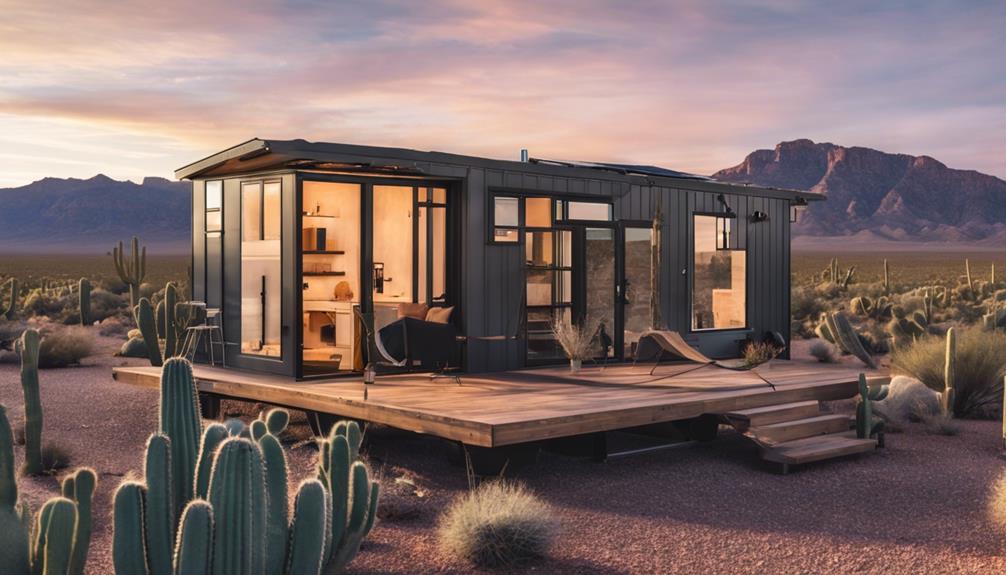
Embarking on the journey of having a tiny home in Arizona is like navigating through a desert oasis, each step revealing new insights and challenges. From understanding the intricate web of zoning laws to discovering the perfect location that aligns with your tiny living dreams, this essential guide equips you with the knowledge needed to turn your tiny home vision into reality.
But what about the unique tax considerations that come with owning a tiny home in Arizona? Stay tuned to uncover key insights that will make a difference in your tiny home journey.
Key Takeaways
- Understand Arizona zoning laws for placement in suitable zones.
- Seek permits for tiny homes based on location and structure type.
- Explore tax benefits for tiny homeowners through property tax exemptions.
- Build a supportive community through local groups and events for guidance.
Zoning Laws and Regulations in Arizona
When navigating the realm of tiny home living in Arizona, understanding the intricacies of zoning laws and regulations becomes paramount. In Arizona, zoning laws permit tiny houses on foundations in multifamily, detached single-family, and accessory dwelling unit zones.
However, for Tiny Homes on Wheels, they're typically classified as recreational vehicles and must adhere to specific parking regulations within designated zones. Maricopa County has established particular regulations for tiny houses, including constraints on the floor area allowed for permanent structures. On the other hand, Pima County imposes restrictions on Tiny Homes on Wheels through specific codes that govern their placement.
The zoning options for tiny houses in Arizona encompass various zones such as isolated single-family zones, accessory dwelling unit zones, and multifamily zones. Familiarizing oneself with these zoning laws and regulations is crucial for anyone considering embarking on the adventure of tiny home living in Arizona.
Ideal Locations for Tiny Homes
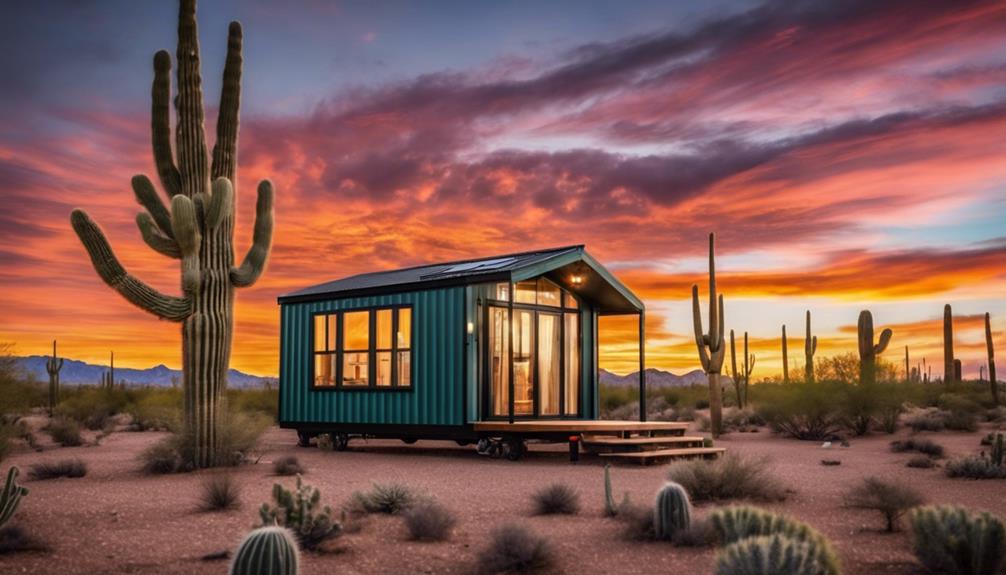
For those seeking ideal locations to establish their tiny homes in Arizona, cities like Phoenix, Tucson, Sedona, and Lakeside present attractive options. When considering where to set up your tiny home in Arizona, keep in mind that Pima County and Coconino County permit the establishment of tiny houses in specific zones. In these areas, tiny homes can be placed in isolated single-family zones, ADU zones, and multifamily zones. For those with tiny houses on wheels, it's important to note that they must be parked in designated R.V. zones in compliance with regulations.
- Phoenix, Tucson, Sedona, and Lakeside are ideal cities for setting up tiny homes in Arizona.
- Pima County and Coconino County allow tiny houses in specific zones.
- Tiny homes can be placed in single-family zones, ADU zones, and multifamily zones.
- Tiny houses on wheels must adhere to regulations in designated R.V. zones.
Tax Considerations for Tiny Home Owners
Exploring the tax implications of owning a tiny home in Arizona reveals potential benefits and considerations that can significantly impact financial planning for homeowners. Tiny home owners in Arizona may qualify for property tax exemptions based on factors like square footage and adherence to green building standards. Additionally, the size of tiny homes could lead to reduced property tax assessments in certain counties. It is crucial for Arizona tiny home owners to familiarize themselves with local tax laws to take advantage of any available tax benefits. Seeking guidance from a tax professional or local tax assessor can provide valuable insights into how owning a tiny home in Arizona may influence property taxes.
Tax Considerations for Tiny Home Owners:
| Key Points | Details | Importance |
|---|---|---|
| Property Tax Exemptions | Available based on square footage and green standards | Maximize Savings |
| Reduced Assessments | Smaller homes could mean lower tax bills | Financial Advantage |
| County Variances | Regulations differ, impacting tax benefits | Local Compliance |
| Professional Advice | Consult with tax professionals for guidance | Optimal Planning |
Finding Community Support in Arizona

By actively engaging with local resources and networking opportunities, tiny home enthusiasts in Arizona can establish a strong sense of community support to enhance their living experience.
Here are some ways to find community support in Arizona:
- Join local Facebook groups like 'Arizona Tiny House Community' for a supportive network.
- Attend tiny house meetups and events in Arizona to connect with like-minded individuals.
- Explore tiny house workshops and seminars in the state to gain knowledge and resources.
- Consider volunteering with non-profit organizations focused on sustainable living and tiny house advocacy in Arizona.
These opportunities not only provide a sense of belonging within the tiny house community but also offer valuable insights, resources, and support for those embracing the tiny home lifestyle in Arizona.
Engaging with these avenues can enrich your experience, foster connections, and empower you to navigate the challenges and joys of sustainable living in the state.
Building and Parking Tips for Tiny Homes
Engaging with the regulations and guidelines for building and parking tiny homes in Arizona is crucial for ensuring compliance and a smooth transition into sustainable living. Tiny homes on foundations in Arizona must adhere to the 2018 IRC Appendix Q requirements, which outline specific space dimensions and safety features to guarantee structural integrity.
Building a tiny home on skids offers a semi-permanent placement option while still allowing for mobility if relocation becomes necessary. For those opting for tiny homes on wheels, meeting mobile home requirements is essential, and a minimum of 160 square feet is required for parking.
The flexibility in setting up tiny homes in various zone types in Arizona provides diverse housing options based on individual preferences. Tiny houses on wheels are particularly popular for their mobility and flexibility, making them an attractive choice for those desiring a minimalist lifestyle without sacrificing comfort.
Frequently Asked Questions
Can I Put a Tiny House on My Property in Arizona?
Yes, we can put a tiny house on our property in Arizona if it complies with local zoning regulations. Different options like multifamily, detached single-family, or accessory dwelling units are available. Land near Maricopa City, Pinal County, offers accessible placement.
How Much Does a Tiny House Cost in Az?
Tiny houses in Arizona can range from $20,000 to $200,000 depending on size and customization. DIY kits start at $8,000, but labor costs add up. Land, utilities, and permits are extra. Building a tiny house can be a cost-effective housing choice.
What Is the Minimum Square Footage for a House in Arizona?
In Arizona, the minimum square footage for a house varies based on its foundation type. For tiny houses on foundations, it's 200 square feet, while those on trailers require at least 160 square feet. Adhering to building codes is essential.
Does Arizona Have a Tiny Home Community?
We do have tiny home communities in Arizona. These communities provide shared amenities, community engagement, and a supportive environment. Living in a tiny house community offers a unique sense of belonging, shared resources, and a close-knit experience.
Conclusion
In conclusion, navigating the world of tiny homes in Arizona may seem like a daunting task, but with the right resources and community support, it can be a breeze.
From zoning laws to building tips, we've covered it all in our essential guide.
So go ahead, take the leap into tiny home living and watch your dreams of a cozy, sustainable lifestyle come to life in the Grand Canyon State!
- About the Author
- Latest Posts
Introducing Ron, the home decor aficionado at ByRetreat, whose passion for creating beautiful and inviting spaces is at the heart of his work. With his deep knowledge of home decor and his innate sense of style, Ron brings a wealth of expertise and a keen eye for detail to the ByRetreat team.
Ron’s love for home decor goes beyond aesthetics; he understands that our surroundings play a significant role in our overall well-being and productivity. With this in mind, Ron is dedicated to transforming remote workspaces into havens of comfort, functionality, and beauty.
-

 Vetted5 days ago
Vetted5 days ago15 Best Fillers for Concrete Cracks – Expert Recommendations and Reviews
-

 Vetted7 days ago
Vetted7 days ago15 Best Plants for Large Pots to Transform Your Outdoor Space
-

 Vetted6 days ago
Vetted6 days ago15 Best Fairy Lights to Transform Your Space With Magical Illumination
-

 Vetted1 week ago
Vetted1 week ago15 Best Folding Beds for Small Spaces – Space-Saving Solutions for Comfort and Convenience
-

 Vetted1 week ago
Vetted1 week ago15 Best Waterproof Flooring Options for Your Bathroom – Ultimate Guide & Reviews
-

 Vetted2 weeks ago
Vetted2 weeks ago15 Best Grocery Carts to Make Shopping a Breeze
-

 Vetted21 hours ago
Vetted21 hours ago15 Best Subfloor Options for Your Basement Renovation – Ultimate Guide
-

 Vetted3 weeks ago
Vetted3 weeks ago15 Best Gravel for Driveway: The Ultimate Guide for a Durable and Stunning Entrance

























